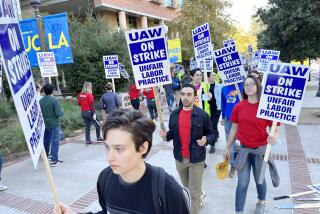Misleading Ads Anger Both Sides in School Voucher Fight
Both sides in the hard-fought battle over school vouchers have launched increasingly strident and misleading advertisements as the vote on Proposition 38 draws closer.
The added exposure on the airwaves and in political mailers has done little to clarify the central question of the proposition--whether students should be eligible for $4,000 vouchers of public funds to help them attend private schools.
Instead, ads for and against the November ballot measure have made it seem more like a referendum on crime reduction, educational discrimination and the level of commitment by teachers to their public schools.
Voucher proponents have hit hard at public school teachers, saying they send their own children to private schools in large numbers but don’t want to help others do the same. Those fighting the measure have tried to make it appear that vouchers would discriminate against the poor and “abandon” many children.
Both sides have demanded retractions from their opposition and appealed for television stations to drop the spots. None of the ads, however, have been withdrawn.
Polls have shown opposition to the measure increasing, while support has remained stagnant for several months at about 36%.
But with less than three weeks until the election, the Yes on 38 campaign seems to be intensifying its efforts. Funded largely by Silicon Valley venture capitalist Timothy Draper, the campaign has spent twice as much as the anti-voucher forces, which have drawn their financial support mostly from teachers unions.
The campaigns for and against Proposition 38 had spent $47 million by the end of September, far more than expenditures for any other office or measure on California’s Nov. 7 ballot.
The Yes on 38 campaign has paid out $31.4 million, records show. Opponents, primarily the California Teachers Assn., have spent half that, $15.7 million, with about $6 million more in the bank.
Among the most provocative and controversial ads in favor of Proposition 38 are those suggesting that many Los Angeles public school teachers send their children to private schools but don’t want to give others that opportunity.
Television ads and 60-second radio spots receiving wide airplay say that “40% of schoolteachers in Los Angeles send their children to private schools.” On radio, the ad continues: “The public schools aren’t good enough for their kids, but they’re supposed to be good enough for yours.”
In justifying that statement, the Yes on 38 forces cite an analysis of 1990 census data by voucher advocate Denis P. Doyle.
Doyle’s 5-year-old study attempted, in several American cities, to measure the number of public and private school teachers who had children in private schools.
When private school teachers were removed from the equation, Doyle actually found that 30% of public school teachers living in Los Angeles sent their children to private schools. That is short of the 40% claimed in the ad, but more than the 19.5% of all city parents with children in private schools.
Teachers complained that the ads make it appear that the figures are for the Los Angeles Unified School District when, in fact, Doyle did not compile the information by school district.
Los Angeles educators objected that even Doyle’s 30% figure exaggerates their use of private schools because it doesn’t account for teachers who live in Los Angeles but work elsewhere.
United Teachers-Los Angeles officials said this week that a phone survey of 128 teachers with school-age children found 17% had them in private schools. More than half of those were in parochial schools--suggesting that religion might have been the prime reason for some teachers’ decisions.
“This really bothers teachers, because they are being lied about,” said Day Higuchi, president of United Teachers-Los Angeles. “They support, believe in and honor the public schools--the institution they have devoted their lives to.”
The Yes on 38 campaign provoked another angry response this week with a mailer it sent to thousands of households statewide. “Prop. 38 Yes . . . because saving public education also means saving lives,” headlined the mailer.
A photo of a menacing young man with an eyebrow ring is next to the words: “Lock your doors.” The pamphlet says the voucher measure will “put an end to the rising population of dropouts who commit thousands of violent crimes each year, including 82,213 violent crimes against senior citizens.”
In fact, campaign officials concede that the state does not track the educational status of those committing violent crimes. They also acknowledge that the 82,213 figure for attacks on senior citizens is an eight-year total, not a single-year number, as the ad implies.
Infuriated by the mailer, four senior citizens organizations held a joint news conference in Sacramento earlier this week. They said the mailer needlessly scares older people and makes a false connection between vouchers and preventing violent crime.
Those older than 60 are less likely than people in other groups to be victims of violent crime, AARP representatives said. Betty Perry, public policy director for the Older Women’s League, added: “School vouchers have nothing to do with crimes against older persons.”
Pro-voucher forces stand by the mailer. Spokesman Chris Bertelli said it “makes an accurate connection between people who drop out of school and what that translates into for people who vote, but might not think education has anything to do with them.”
On Wednesday, the voucher campaign drew yet another round of criticism, this time from Latino elected officials.
State Sen. Richard Polanco (D-Los Angeles) and others objected, in particular, to a television graphic that says Proposition 38 “gives parents 4,000 dollars.” In fact, the payments would go directly to schools.
Opponents of vouchers have also been buffeted by complaints about their advertisements, which routinely depict the $4,000 chits as an untested scheme, without proper controls or public accountability.
Perhaps the most strident claim by the anti-voucher forces comes at the end of a 30-second television ad in Spanish. The ad begins with two grade-school-age children looking through a voter pamphlet while a narrator states: “Proposition 38 voucher schools can discriminate against students.”
It goes on to say that children can be kept out of the schools if they don’t speak English, for their religion or if their families are poor.
Indeed, private schools under the initiative will remain free to choose the students they admit. If $4,000 isn’t enough to pay tuition at a school, for instance, a child without additional money could be excluded. And private schools will continue to be permitted to serve students of a single religion or to teach in English alone.
But Proposition 38 prohibits schools that accept vouchers from discrimination based on race, ethnicity or national origin--a fact that is anything but clear in the “No” ads.
The “discrimination” spot climaxes with the extreme claim: “Under Proposition 38, kids that do not qualify for private schools will be abandoned.” The statement seems to imply that those students would be left without any school to attend. On screen, the students who have been reading the measure look dumbfounded.
No on 38 spokesman Jon Lenzner conceded that no children would be left without schools. But he insisted the term “abandon” is justified, because, “as you siphon [financial] resources out of the public schools, in effect, you are abandoning a child left in the public schools.”
Yes on 38 campaign spokesman Bertelli called the ad “just another scare tactic.”
The voucher campaign has also reacted vehemently against opponents’ claims that schools accepting vouchers will have “no accountability” and will not even have to disclose what they teach. That message is most frequently heard on the “swinging lightbulb” television ad, in which a bare bulb blinks off after a narrator describes all the purported shortcomings of the initiative.
Indeed, current private schools and any new ones that would receive vouchers would have to disclose much less financial information than public schools, which must report details of even small expenditures.
But schools that take vouchers would have to make available at least a record of their total revenue, expenses and debts.
Beyond financial accountability, the measure would require schools that accept vouchers to administer the same standardized test, probably the Stanford 9, that is required in the public schools.
Test results would have to be made available to parents and the public.
As to disclosure of academic offerings, the state Education Code already requires 10 minimal subject areas for students in kindergarten through sixth grade, ranging from English to economics, art and music. The code adds seven other requirements for students in middle school and high school.
It would be up to schools that take vouchers to disclose any courses they offer in addition to those minimum requirements.
“To say there is no accountability,” Bertelli said, “is just false.”
(BEGIN TEXT OF INFOBOX / INFOGRAPHIC)
Proposition 38: School Vouchers
Each side accuses the other of running misleading ads about the measure, which would give parents a voucher worth at least $4,000 to send a child to private school. Here is a look at both sides’ advertisements:
*
Sponsor: Yes on 38
Media: Radio and television
Claim: “Forty percent of schoolteachers in Los Angeles send their children to private schools.”
Accuracy: Misstates own survey. Poll actually suggests that 30% of public school teachers living in Los Angeles send their children to private schools, but it cannot say how many of those residents teach in Los Angeles or elsewhere.
*
Sponsor: Yes on 38
Medium: Mailer
Claim: The measure will “put an end to the rising population of dropouts who commit thousands of violent crimes each year, including 82,213 violent crimes against senior citizens.”
Accuracy: The state keeps no figures linking dropout rates to crime. The 82,213 figure is an eight-year composite, not a one-year figure.
*
Sponsor: No on 38
Medium: Television Claim: Private voucher schools will have no financial or academic “accountability.”
Accuracy: Financial reporting would be less comprehensive than for public schools, but voucher schools would report revenues, expenses and debts. Schools would administer national tests, probably the Stanford 9, and report results.
*
Sponsor: No on 38
Medium: Television
Claim: “Proposition 38 voucher schools can discriminate against students .... Kids that do not qualify for private schools will be abandoned.”
Accuracy: The measure prohibits racial discrimination. Sponsors concede that no student will be without a school option. Those who can’t get into a private school can remain in a public one.
More to Read
Start your day right
Sign up for Essential California for news, features and recommendations from the L.A. Times and beyond in your inbox six days a week.
You may occasionally receive promotional content from the Los Angeles Times.







